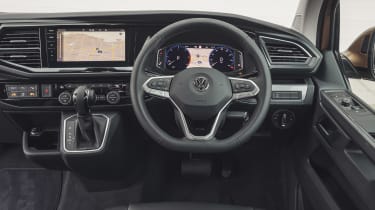Volkswagen Caravelle (2015-2022) review - Engines, performance and drive
The Caravelle is tuned for long distance comfort and it’s better on the motorway than it is through the corners

If you’re worried about the VW Caravelle seating your most important clients atop a van chassis designed primarily to transport inanimate cargo, don’t be. Firstly, the Volkswagen Transporter is one of the smoothest riding vehicles in the mid-sized panel van class and secondly, VW engineers have comprehensively retuned the Caravelle’s suspension for the express purpose of keeping demanding occupants onside.
The ride is good even by passenger car standards with the cabin well isolated from bigger bumps and potholes. A downside of this softness is that occupants can experience a background wobble on some surfaces but despite this, the vehicle never feels floaty or disconnected from the road over undulations. Attempt to corner the Caravelle too briskly and you’ll be warned off by the pronounced body roll long before the CEO in the back seat tells you to calm down but the electronic power steering system is accurate enough and at low speeds the Caravelle is surprisingly maneuverable. Parking and reversing are aided by the high driving position giving great all-round visibility and the array of driver aids that we’ll touch on later.
Also in the interests of ensuring occupants arrive at their destination feeling refreshed, the Caravelle has far lower noise levels that the van it shares a platform with. There are thuds from the suspension on poor surfaces but at motorway cruising speeds the engine is almost inaudible and road noise is well muted. There’s quite a bit of wind noise around those generous door mirrors as speeds creep up and asking the gearbox to kick down for a burst of acceleration will bring a muffled roar from the engine bay. General refinement, though, is better than you would expect - if not on a par with the bast premium SUVs and saloons cars.
Engines, 0-60 acceleration and top speed
It’s the VW Group’s ubiquitous 2.0-litre diesel engines all the way for the Caravelle. That means entry-level buyers get the TDI 150 with 148bhp and 340Nm of torque between 1,500 and 3,000rpm. It’s not what you would call quick, partly as a result of the basic car’s 2,330kg kerb weight, but the Caravelle doesn’t reward spirited driving anyway. The 0-62mph takes 13 seconds but there’s a 112mph top speed and the vehicle has no trouble dicing with motorway traffic.
Opt for the BiTDI 199 twin-turbo engine and you get 196bhp plus 450Nm between 1,400 and 2,400rpm. The 0-62mph time is reduced to 10.1 seconds, or 10.3 seconds if you also choose 4Motion all-wheel drive, and the top speed rises to 124mph. With both engines, the DSG gearbox is smooth and shifts are almost unnoticeable if you fall into that easy-going driving style that suits the Caravelle best.








